According to Maori legend, the boulders are the remains of gourds, calabashes, and sweet potatoes of sailing deities.
Part of a strange global geological phenomenon, unusually large, near-perfect spherical boulders can be found on a lonely beach around 40 kilometres from the town of Oamaru in New Zealand’s South Island.
The Moeraki boulders, also known by their Maori name of “Kaihinaki,” lie on Koeohe Beach and have delighted tourists and intrigued scientists alike over the years, with their distinct shape and size reaching 2.2 metres in diameter.
A curiosity since Victorian times, numerous theories have been advanced about their origin.
In the Maori Te Reo language, Moeraki means “a place to sleep by day.” The name originates from a tale of the ancient navigator Kupe who was said to have left his iwi (tribe) behind to rest at Moeraki as he explored the South Island.
Maori legend attributes the sphere’s origin to the wreck of a large canoe, the Araiteuru, which carried the ancestors of the Ngai Tahu tribe endemic to the South Island.
According to the legend, the boulders are the remains of gourds, calabashes, and kumaras (sweet potatoes) that washed ashore after the canoe sank, turning over time into stone.
Another tongue-in-cheek explanation, possibly inspired by the 1988 movie Cocoon, is that the boulders are simply hatched Alien eggs.
Modern science paints a slightly different tale as to the boulder’s origins, saying they are concretions, which are formed when mineral cement fills the spaces between sediment particles and hardens over time. The boulders are composed of mud, silt, and clay, with the largest ones estimated to weigh several tons.
The boulder’s composition adds to the curiosity, particularly with the fact they have a hollow core addled with large cracks called “septaria” that radiate outward.
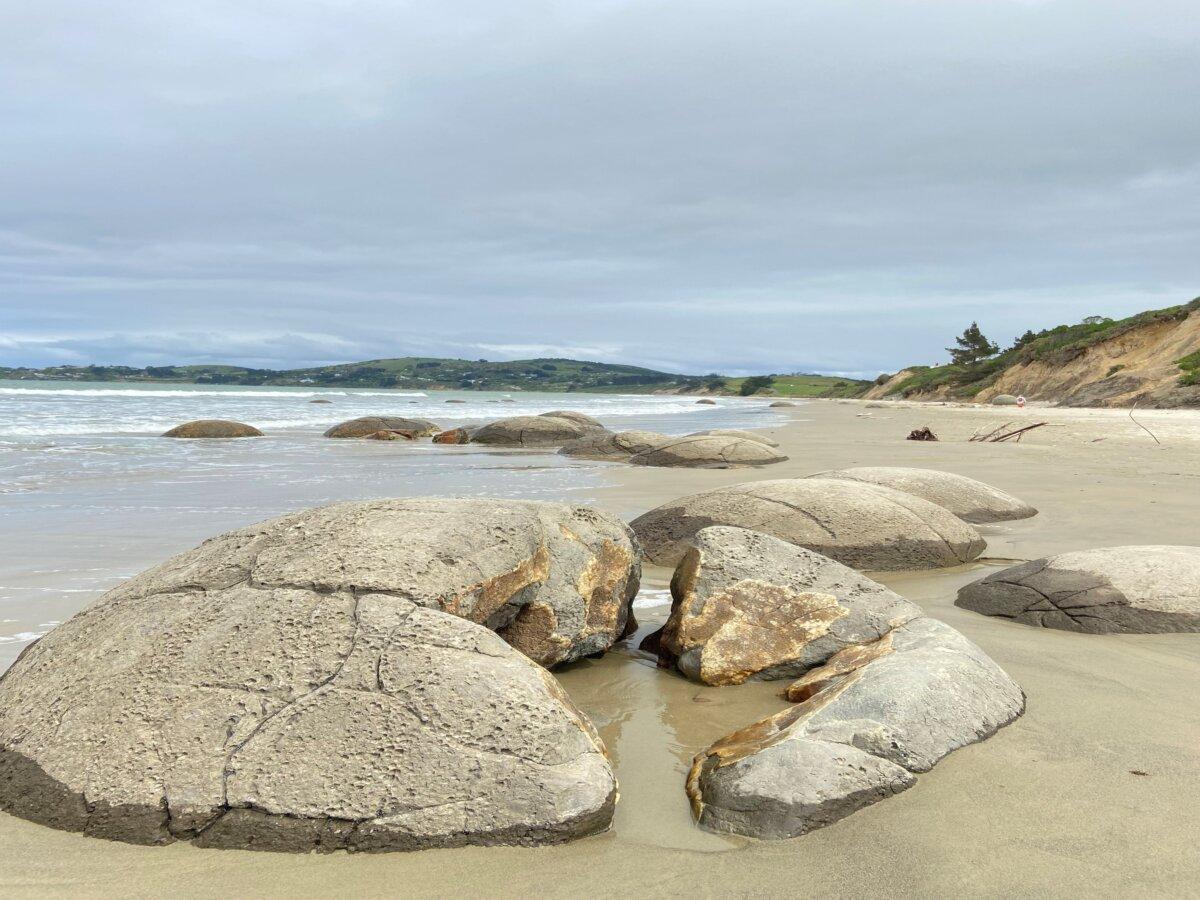 The Moeraki Boulders, unusually large spherical boulders spread out along a section of the Otago coast, in New Zealand on Dec. 6, 2022. (Daniel Teng/The Epoch Times)
The Moeraki Boulders, unusually large spherical boulders spread out along a section of the Otago coast, in New Zealand on Dec. 6, 2022. (Daniel Teng/The Epoch Times)When Were They Created?
A central theory points to their creation millions of years ago on the sea floor.
According to this assumption, mineral-rich mud and silt accumulated around a central core, such as a fossil or shell, and gradually hardened into spherical shapes. Over time, erosion of the surrounding rock formations exposed these concretions, eventually leading them to be revealed on the beach.
Another theory suggests that the boulders were formed much more recently, during the Paleocene epoch, around 60 million years ago.
During this time, the boulders may have formed within ancient sea cliffs and were later exposed by coastal erosion. This theory is supported by the presence of similar concretions in nearby cliffs, which have been dated to the same period.
Regardless of their origins, the Moeraki Boulders are a stunning sight to behold, particularly at sunrise or sunset when they cast long shadows on the beach.
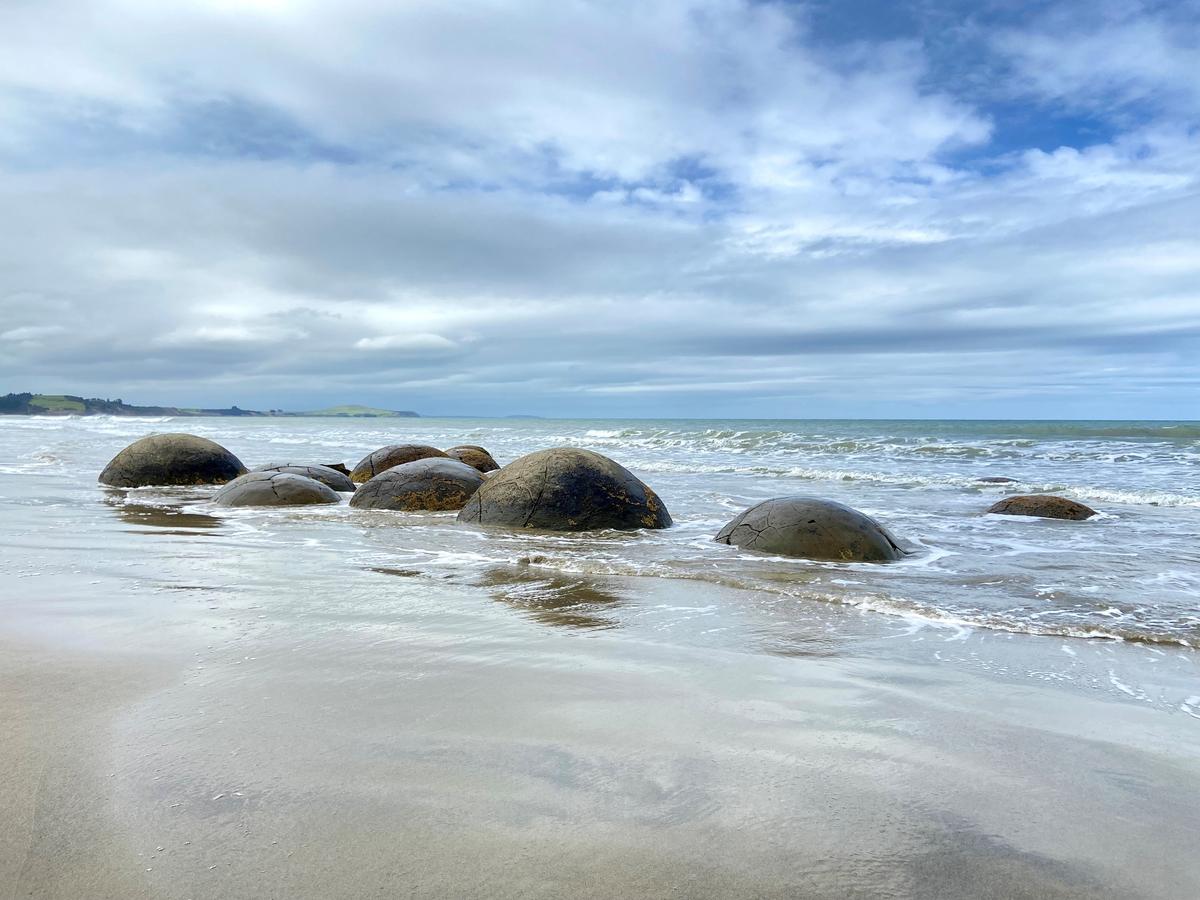 The Moeraki Boulders, unusually large spherical boulders spread out along a section of the Otago coast, in New Zealand on Dec. 6, 2022. (Daniel Teng/The Epoch Times)
The Moeraki Boulders, unusually large spherical boulders spread out along a section of the Otago coast, in New Zealand on Dec. 6, 2022. (Daniel Teng/The Epoch Times)The boulders have become a popular tourist attraction, drawing visitors from around the world to marvel at their size and shape. The surrounding area offers plenty of opportunities for exploration, with scenic walks along the beach and nearby cliffs providing breathtaking views of the coastline.
Despite their popularity, the Moeraki Boulders are also fragile and are protected by law to prevent damage or removal. Visitors are encouraged to admire them from a distance and to respect the natural environment in which they are found.
Unusual spheres are not unique to the South Pacific, however, in the United States, Bowling Ball Beach, part of Schooner Gulch State Beach in Mendocino County, California, is named after its spherical sandstone boulders that emerge at low tide.
Costa Rica famously also has a set of 300 perfectly large stone spheres scattered across Diquís Delta and on Isla del Caño.
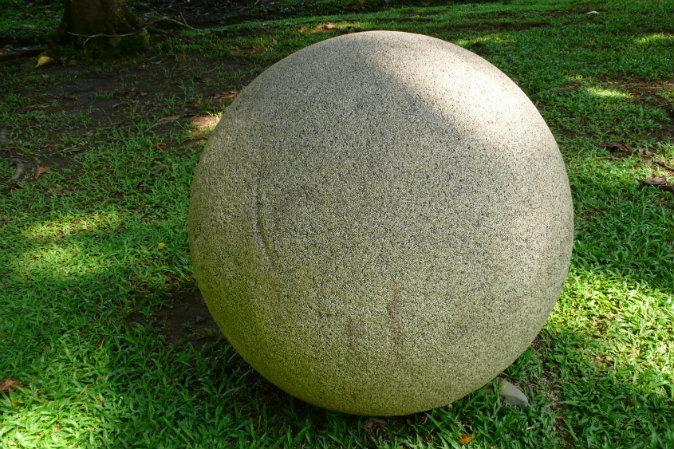 One of many mysterious stone spheres in Costa Rica. (Cindy Drukier/Epoch Times)
One of many mysterious stone spheres in Costa Rica. (Cindy Drukier/Epoch Times)The Koutu Boulders
In Northland, The Koutu Boulders, are a lesser-known but equally remarkable geological formation located on Koutu Beach, in the Hokianga Harbour of New Zealand’s North Island.
Similar in appearance to the Moeraki Boulders, the Koutu Boulders have also fascinated visitors with their size, shape, and mysterious origins.
The Koutu Boulders are typically smaller than their Moeraki cousins, ranging in the main from about 0.5 to 1 meter in diameter, although there are a few bigger specimens.
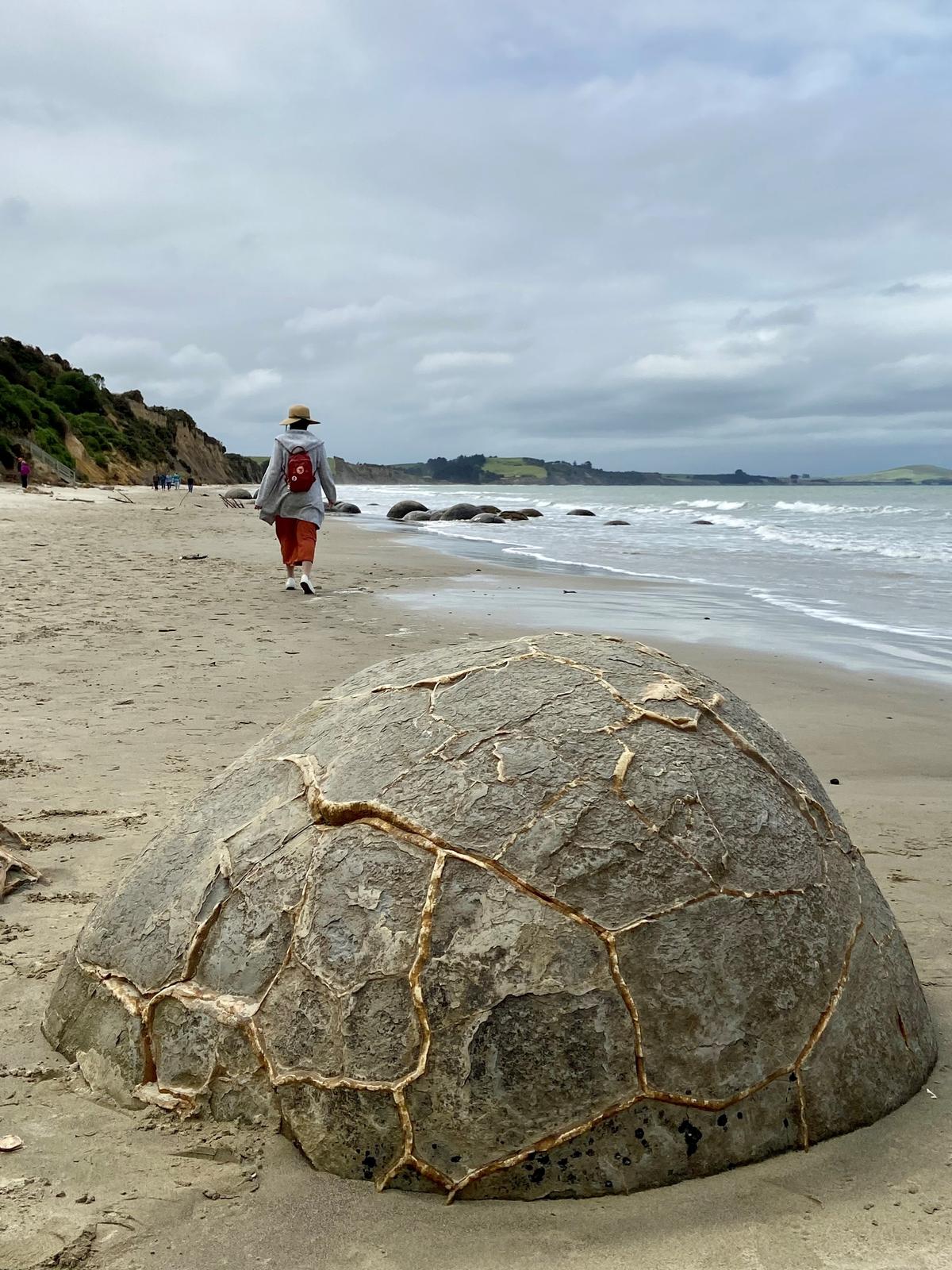 The Moeraki Boulders, unusually large spherical boulders spread out along a section of the Otago coast, in New Zealand on Dec. 6, 2022. (Daniel Teng/The Epoch Times)
The Moeraki Boulders, unusually large spherical boulders spread out along a section of the Otago coast, in New Zealand on Dec. 6, 2022. (Daniel Teng/The Epoch Times)Like their southern counterparts, the Koutu Boulders are formed from sedimentary rock, with layers of mudstone and siltstone cemented together over millions of years to create their spherical shape. They are often partially buried in the sand, with only a portion visible, giving them a unique and intriguing appearance.
One of the most interesting aspects of the Koutu Boulders is their location within the Hokianga Harbour, a place of great cultural significance for the Maori people of New Zealand.
Hokianga Harbour is inextricably linked to the sand of Maeraki by the aforementioned navigator Kupe.
Legend says the Harbour was the departure point from where he returned to his homeland of Hawaiki. According to the Maori history site Te Ara, Kupe is said to have left behind two taniwha (water spirits), which guided later Polynesian arrivals to a safe landing.
Regardless of what origin story one believes, the boulders’ unique appearance and mysterious backstory conveyed to a new generation by oral historians, continue to captivate and add to the rich tapestry of natural wonders that can be found throughout the Land of the Long White Cloud.

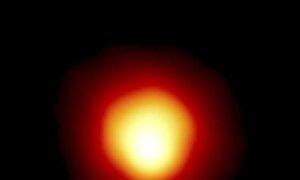
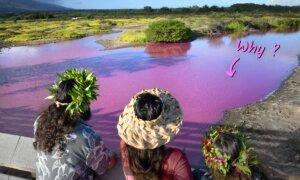







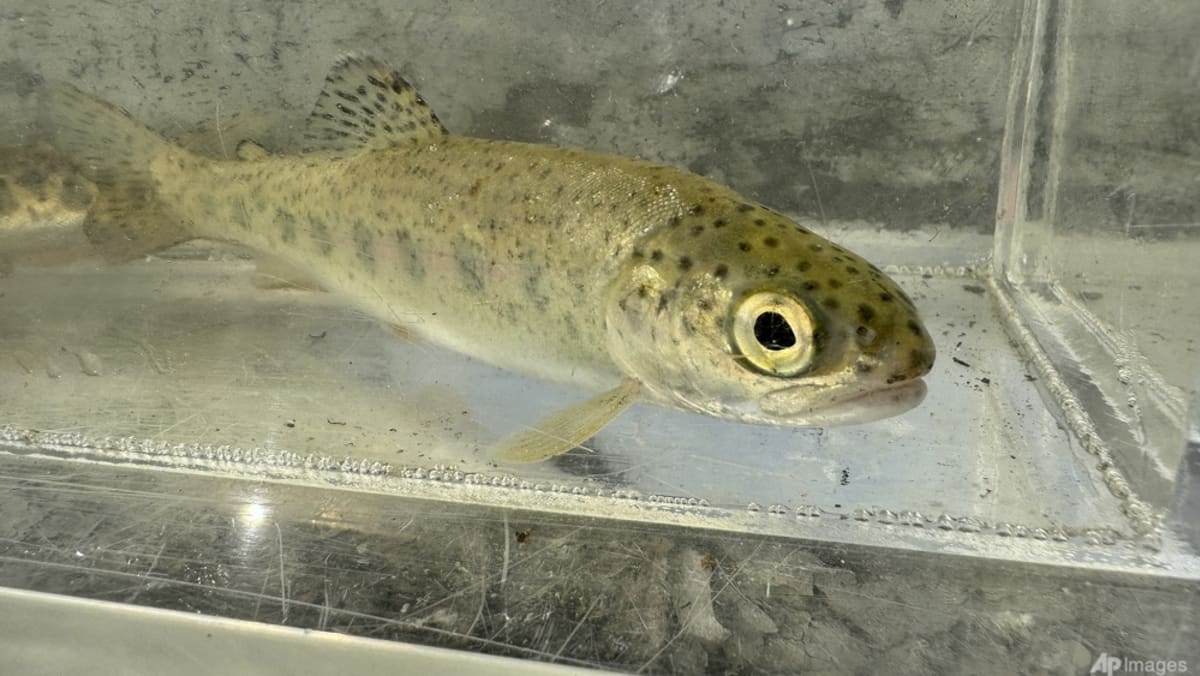



 English (US) ·
English (US) ·  Turkish (TR) ·
Turkish (TR) ·